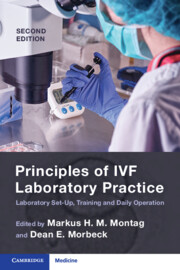Book contents
- Principles of IVF Laboratory Practice
- Principles of IVF Laboratory Practice
- Copyright page
- Contents
- Contributors
- Foreword
- The Evolution of IVF Practice
- Section 1 Starting a New Laboratory and Training Protocols
- Section 2 Pre-procedure Protocols
- Section 3 Gametes
- Section 4 Insemination/ICSI
- Chapter 21 General Insemination for IVF
- Chapter 22 Conventional IVF with Short Co-incubation
- Chapter 23 Technical Aspects of ICSI for Ejaculated Spermatozoa
- Chapter 24 Set-Up and Adapted Protocol for Piezo-ICSI
- Chapter 25 Sperm Selection for ICSI by Morphology
- Chapter 26 Sperm Selection for ICSI by Viability
- Chapter 27 Artificial Oocyte Activation for IVF
- Section 5 Fertilization Assessment
- Section 6 Embryo Assessment: Morphology and Beyond
- Section 7 Embryo Cryopreservation
- Section 8 Embryo Transfer
- Section 9 Quality Management
- Index
- References
Chapter 23 - Technical Aspects of ICSI for Ejaculated Spermatozoa
from Section 4 - Insemination/ICSI
Published online by Cambridge University Press: 07 August 2023
- Principles of IVF Laboratory Practice
- Principles of IVF Laboratory Practice
- Copyright page
- Contents
- Contributors
- Foreword
- The Evolution of IVF Practice
- Section 1 Starting a New Laboratory and Training Protocols
- Section 2 Pre-procedure Protocols
- Section 3 Gametes
- Section 4 Insemination/ICSI
- Chapter 21 General Insemination for IVF
- Chapter 22 Conventional IVF with Short Co-incubation
- Chapter 23 Technical Aspects of ICSI for Ejaculated Spermatozoa
- Chapter 24 Set-Up and Adapted Protocol for Piezo-ICSI
- Chapter 25 Sperm Selection for ICSI by Morphology
- Chapter 26 Sperm Selection for ICSI by Viability
- Chapter 27 Artificial Oocyte Activation for IVF
- Section 5 Fertilization Assessment
- Section 6 Embryo Assessment: Morphology and Beyond
- Section 7 Embryo Cryopreservation
- Section 8 Embryo Transfer
- Section 9 Quality Management
- Index
- References
Summary
Intracytoplasmic sperm injection (ICSI) was first described in 1992 as the ultimate tool for treating couples plagued by male factor infertility. Since then, it has become the most prevalent assisted reproductive technology (ART) treatment in the world, due to its incredible versatility and expanding cohort of indications for use. ICSI requires both a dedicated laboratory setup and knowledgeable and skilled embryologists in order to competently treat infertile couples. In this chapter, we will briefly describe the procedure, indications, required equipment and proper protocol in order to achieve reliable ICSI results and maintain consistent clinical outcome.
- Type
- Chapter
- Information
- Principles of IVF Laboratory PracticeLaboratory Set-Up, Training and Daily Operation, pp. 170 - 177Publisher: Cambridge University PressPrint publication year: 2023



